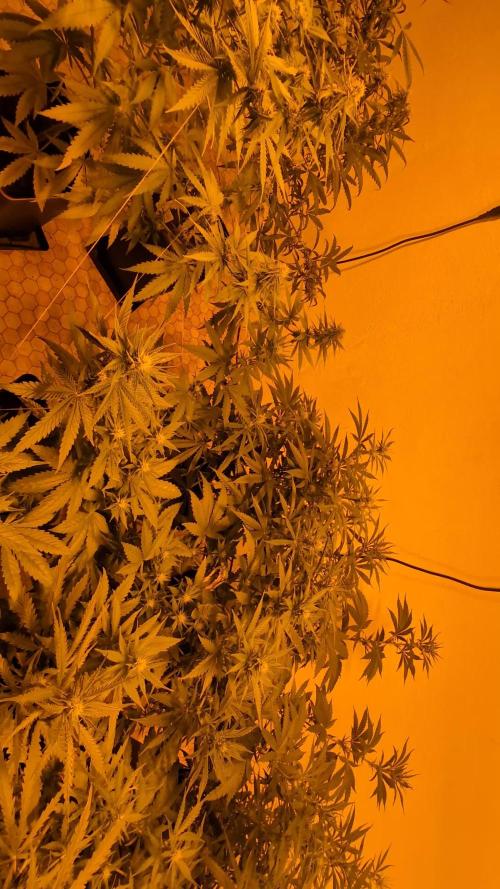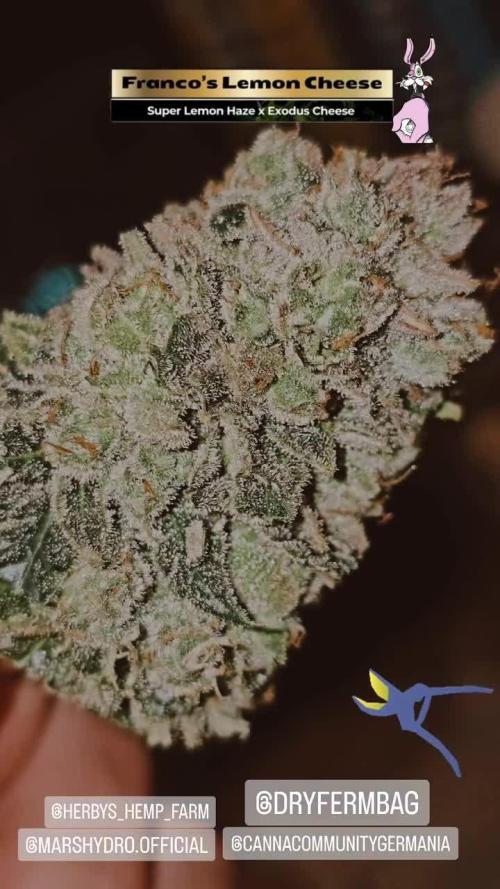The Grow Awards 2026 🏆 



























Processing
Likes
Comments
Share


@nbhnc
Follow
Fixed my lighting up to where the cheese is not getting overwhelmed. Had a case of light bleaching going on.... Lollipoped the girls and did a little defoliation on larger fan leaves. Adding 1 tablespoon per gallon of unsulfered molasses.
Likes
43
Share


@Indica_Jones
Follow
Anfang der woche wurden die Babys mit 10 Liter Wasser ohne Dünger gegossen der PH betrug 6,5 und sie haben direkt angefangen zu mängeln ! habe draufhin mit der vollen Dosis Hesi Chema gedüngt und sie haben sich rasch erholt ! heute (Samstag) habe ich das Licht auf 12/12 umgestellt mal sehen wie sie sich in der Vorblüte machen :) ich jedenfalls bin gespannt und wirklich Stolz dass ich wieder mein ganzes ScrOGnetz mit Trieben füllen konnte.
Likes
10
Share


@PopsFarm
Follow
Day 52 - Fat Monkey Auto from @anesiaseeds
Nutrients: @atami_deutschland / @atami.international / @stefan_atami / @daniel_atami
Soil: @promixgrowers_eur / @promixgrowers_global / @promixgrowers_unfiltered / @promixmitch
LED: @powerlux_spain
Tent: @secretjardin_
Thank you to everyone who follows and supports my work 🙏🏻💚
This means a lot to me and you should know you are a part of it and only with you all this is possible, you are the best community 😎
Growers love, love for everyone
Likes
22
Share


@Reyden
Follow
Le ragazze sono più o meno in forma, ho trapiantato ieri 3 di loro tranne papaya zoap che è nata a qualche giorno dopo al secondo tentativo e quindi per lei aspetterò ancora un po’..oggi ho fatto LST sulle 3 più avanti, vediamo questi giorni come si comportano, questa volta ho usato il box 80x80x160cm e quindi dovrò stare attento con le altezze 😃
🤞
Likes
112
Share


@Tropicannibis_Todd
Follow
ALRIGHTY THEN
👉THEY ARE READY , BUT IM JUST GONNA GIVE IT MORE TI E TO AMBER UP👈
We just hit week 14 and all is well , have to admit shes just killing it on the resin development 😃 ......the frost is insane 👹...... Just waiting for her to ripen up👈
👉NutriNPK NUTRIENTS USED FOR FEEDING👈
www.nutrinpk.com
Lights being readjusted and chart updated .........👍
I GOT MULTIPLE DIARIES ON THE GO 😱 please check them out 😎
👉THANKS FOR TAKING THE TIME TO CHECK OUT MY DIARIES 👈
Likes
59
Share


@Jsammy09
Follow
Not a lot happened last week, just monitoring, feeding, and keeping everything in check while the girls did their thing. I did switch over to my finishing nutrients and have cut out calmag according to feeding chart I have been following. I think we are gettting pretty close to harvest though! The trichomes are starting to get a little milky. I am going to wait until about 30% amber to harvest though. I am getting super excited to finish this one and start my next run!
9/2 - The girls have been doing great and are starting to pack on the size and frost nicely! Nothing to do to them really except monitor and keep checking and making sure everything is running at an optimal level. The closer it gets I start to get a little nervous for the dry. I am prepared and have a plan, just hopefully I can get my dry set up as dialed in as I was able to get my grow tent. I will try to post more updates this week. Last week I had company from out of town, so it was difficult to get around to it.
9/5- Just continuing to monitor and check the trichomes, once about 25-30% turn amber I will be harvesting! They are starting to get pretty cloudy right now. When I did the res change yesterday, I switched to just root drip and full tilt and have started flushing, hopefully not too early, but im following my feeding chart.
As always tips and recommendations always welcomed and appreciated! Thanks for checking out my diary!
Likes
35
Share


@eldruida_lamota
Follow
Actualizo las red hot cookies familia, una variedad recién sacada al mercado, este año 2020 a traído bastantes novedades entre ellas, está joya 💎.
Una variedad que bien cultivada, tenemos un 60% de probabilidades de conseguir flores rojas, y eso mola.
Además tiene un alto porcentaje en thc.
Que más podemos pedir 🤷♂️.
.
El ph 5,8 , la temperatura es óptima, en 22/24 grados de media, y la humedad la reduci un poco actualmente está entre el 60/70%.
.
AgroBeta:
0,8 ml x L Piramid , vía radicular.
0,6 ml x L Growth black line , vía radicular.
0,1 gr x L Cancerbero , vía radicular.
0,1 ml x L Tucán , vía radicular.
0,1 ml x L Flash Root , vía radicular.
0,4 ml x L Great Green , vía foliar.
0,05 ml x L Gold Joker, vía radicular.
.
Poco más está segunda semana gente , todo está correcto ya la semana que viene veremos cómo avanza todo, un saludo fumetillas y buenos humos 💨💨💨.
Likes
132
Share


@rhodes68
Follow
1/10 Week 9!
Tara is just turning into a beast at over 3 foot she is taking over and the light is 5 inches from max height... hello super-cropping if I cant bend and secure the tall ones down some.
Giving Tara as much room as possible and alternating between Cal-Mag and Magnesium Sulfate (Epsom salt) foliar feeds just to cover the bases as the rapid growth seems to be causing slight def.
Defoliated both plants a good bit today, Ripley more so than Tara as that is just the leafiest dam plant.
Upping feed to the high end see how they handle it, shifting feeds to mornings rather than lights on in evenings for my convenience. So they will get two feeds rather close together to make the adjustment. Since the next two grows are photos and the light schedule will be "on" at 6AM this is what needs doing.
1/14 New pics
Defol Ripley further, never seen so many leaves. Only two plants in tent so lots of room for Tara which really needs to stop stretching NOW. 😅
1/15 Pic
Bend and secure on highest branches on Tara lowered her about 3" so dropped lights 2" could not justify super-cropping in flower.
Ripley looking damn good
Likes
14
Share


@GrowBuv
Follow
Time to try out some new strains
This time we have Purple Lemonade from FastBuds!
Started off with 24 hours in a glass of water then into a paper towel,then once the taproot was about half an inch I transferred her into a coco pellet. Once she’s broken the soil it’ll be into the tent.
Day 3
Looks like it’s time to up pot her and get her under the light.
Likes
13
Share


@HIAZ_urbanbudfarmer
Follow
These plants are starting to come back nicely .
Unfortunately due to me being extraordinary lazy this grow, not maintaining them properly & not on time & the watering issue they suffered they didn't meet their potential!
Because of this they didn't go through much of a flowering stretch!
Growers if you use the promo code GROWEED, you will receive a 15% discount on any Fast Buds purchase!
Processing
Likes
26
Share


@rhodes68
Follow
8/17 Week 5 Flipping
Lights set to 11-13 for the first few days then 12-12
Nuets will transition accordingly
Took 2 cuttings from her for clones
Reducing feeds to once a day during the switch
Intro Cocotek Bloom a/b at 5ml/gal each
Reduce Grow to 10ml/g each
Next feed half and half
8/19
Switching to 12-12 from 11-13 think its done its work changes are afoot
8/20
Colas forming quickly may have to flip the week to Flower, lets hope so 😉
They getting a dose of Kangaroots 5ml/g and Fish Shit 2ml/g at intervals during transition purely as plants seem to need.
Pics tonight
8/21
Not there entirely yet but wont be long at all
Vertical growth has picked up strongly, 2" in 3 days, though I really wont call it stretch yet
Continued light defoliation keeping center clear
Nuets as is for now
Likes
Comments
Share


@Nickeluring
Follow
It is currently very hot here and the plants are suffering. I´ve upped the silicone dose to help dealing with the heat. We start to see some great bud formations.
Likes
23
Share


@SonomaSungrown
Follow
Skipped a week in my journal due to travels.
Had my neighbor water my plants.
Having some minor early deficiencies with my photoperiod plants (particularly the chem brulee)... so I decided to go ahead and give everything a solid feeding of Foop Bloom 1, 2 and Sweetener. This is their first ever bottled feeding. Have been running on supersoil and a prayer.
Also top dressed everything and mulched with rice straw to help with the soil drying out a bit too quickly.
Leaves have been yellowing on all three. Mostly relegated to the interior of the plants.
Chem Brulee is looking a bit too yellow overall, as well.
French Macaron is a 66in. Chem Brulee is 56in. Pineapple Meatball is 45in.
I have a sneaking suspicion that my neighbor didn't water them quite enough while I was gone.
Will probably continue with the Foop feedings... probably at least once per week. Don't want to overdo it.
Also top dressed with my flowering top dress mix and mulched all plants with a thin layer of rice straw.
8/4 Sprayed with Neem Oil and Castile Soap
8/5 Sprayed with Gravenstein Apple FFJ and OHN
8/6 Sprayed with Neem Oil and Castile Soap (this will likely be the last time I spray with Neem Oil, as I don't want residual oils as buds start swelling. Also fed 1/4 strength FOOP to ensure we head off any deficiencies.
Likes
1
Share


@SessionMeister
Follow
Overall very pleased. All the leaves are dark green and the plants are looking very happy. I’m giving them a couple more days before they are flipping into flower. All of them handle defoliation really well but Somango is a little to bushy to really do any organized Lst. I will try after Defoliation next week and give her a bit more surface area.






























